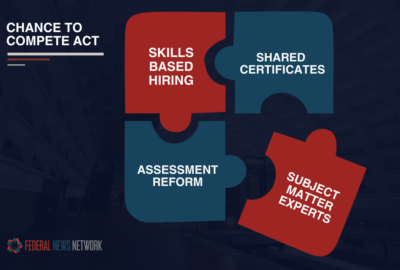After a summer break, Congress has a lot on its plate this fall
The House and Senate appropriations packages are far from the only priority for Congress this fall — and many of the other to-do items have direct impacts for...
After the summer break, Congress has a lengthy, hefty to-do list this fall. And without getting a couple of key items across the finish line, there will be some serious implications for federal employees.
The House and Senate Appropriations committees are far from an agreement on agency spending levels for fiscal 2024. The Senate has advanced all 12 of its appropriations bills out of committee with bipartisan support and plans to move at least three spending bills to a floor vote next week. But the spending package is hitting a wall in the House.
That means top of the list for Congress right now, not surprisingly, is to pass some sort of temporary stop-gap bill by Sept. 30 to avoid a government shutdown.
House Speaker Kevin McCarthy (R-Calif.) and Senate Majority Leader Chuck Schumer (D-N.Y.) are in ongoing discussions over a continuing resolution, a common temporary measure used to avoid a shutdown. But it’s a steep hill to climb.
“A lot of the fight is really about the numbers,” Marc Goldwein, senior vice president and senior policy director for the Committee for a Responsible Federal Budget, said in an interview. “There’s a large share of members of the House that want to spend well below what the Fiscal Responsibility Act topline level is and there are others that aren’t willing or able to agree to those levels.”
The House’s Freedom Caucus, a smaller group of conservative lawmakers, is calling on McCarthy to make major spending cuts for the government’s 2024 budget.
“The question is, are they going to continue to push on this so hard that they create a crisis for Speaker McCarthy and the functioning of the House?” John Hatton, staff vice president of policy and programs at the National Active and Retired Federal Employees Association (NARFE), said in an interview. “At the end of the day, there’s certainly a possibility of a shutdown.”
The debt limit agreement, enacted in June, also included one unique provision. If a continuing resolution is still in place on Jan. 1, 2024, agencies would see a 1% cut for both defense and non-defense spending take effect in April. That’s in direct contrast to the 3% boost to defense spending included in June’s debt limit agreement. The goal is to incentivize Congress to take up appropriations and avoid a long-term CR as well as a shutdown.
During government shutdowns, hundreds of thousands of federal employees are furloughed, meaning they aren’t allowed to work and don’t receive paychecks. Under a 2019 law, they are guaranteed eventual back pay, but shutdowns still have massive consequences.
“In past shutdowns, almost half of the 2.1 million Americans who work for the federal government were furloughed,” Rep. Gerry Connolly (D-Va.) said Thursday on social media platform X, formerly known as Twitter. “These federal employees will not receive back pay until the shutdown is over. Federal contractors, on the other hand, may never receive any back pay at all.”
Now, two lawmakers are trying to end government shutdowns once and for all. Sen. Tim Kaine (D-Va.) and Rep. Don Beyer (D-Va.) reintroduced the bicameral End Shutdowns Act Wednesday. The bill would automatically kick in a continuing resolution on Oct. 1 if Congress can’t reach an agreement on appropriations. The Senate would also be barred from taking up legislation unrelated to government funding.
“Government shutdowns have disastrous consequences for federal employees and government contractors and slow down critical government services,” Kaine said in a press statement Wednesday. “This is unacceptable, which is why I’m reintroducing my bill to prevent government shutdowns.”
But appropriations packages are far from the only priority for Congress this fall — and many other to-do items have direct impacts for federal employees.
Repealing Social Security’s “evil twins”
One bill in Congress is continuing a now decades-long push from bipartisan lawmakers to change part of the 1935 Social Security Act.
The Social Security Fairness Act, which Reps. Garret Graves (R-La.) and Abigail Spanberger (D-Va.), and Sens. Sherrod Brown (D-Ohio) and Susan Collins (R-Maine), introduced in both chambers in January, would revoke two longstanding provisions impacting retirement savings of some federal retirees.
The Windfall Elimination Provision (WEP) reduces or eliminates Social Security benefits for federal employees and other public sector workers who receive an annuity from their time in government, but who also worked in a Social Security-covered job. Similarly, the Government Pension Offset (GPO reduces or eliminates Social Security benefits of the spouses, widows or widowers of those with government pensions.
Last Congress, the Social Security Fairness Act gained broad bipartisan support, with 305 cosponsors in the House and 42 in the Senate. This year’s version of the legislation so far has 289 cosponsors in the House and 45 in the Senate.
With just one more cosponsor in the House, lawmakers would meet the 290-cosponsor threshold to file a motion to put the bill on the House consensus calendar. That could effectively force the Ways and Means Committee to take up the bill and advance it or alternatively force a floor vote, but it remains up in the air.
“Graves has indicated that he wants to try to work with the committee to try to find a path forward for relief, rather than file that motion right away. And he would have some time to do so and still be able to force some action,” Hatton said. “That’s probably a more realistic scenario — a compromise bill — given where the committees have been on this.”
NARFE has been a major advocate of a full repeal of WEP and GPO, saying the pair of provisions unfairly punishes public servants through reduced Social Security benefits.
Other introduced bills that would similarly change WEP and GPO include the Public Servants Protection and Fairness Act, which would provide some relief to feds from WEP, but not fully repeal it. The Social Security 2100 Act would fully repeal both WEP and GPO. Most recently, the introduction of the Equal Treatment of Public Servants Act made another attempt to reduce the effects of WEP by changing the provision’s funding formula.
Bills aiming to limit the Thrift Savings Plan
Lawmakers have also made several attempts to limit investments in the Thrift Savings Plan, a trend that has become increasingly common in the past couple of years.
One policy rider in the House Appropriations committee’s 2024 Financial Services and General Government bill aims to block funds from going toward any TSP mutual fund options that are based primarily on environmental, social or governance (ESG) criteria.
The committee folded language similar to the “No ESG in the TSP Act,” first introduced in May, into the larger appropriations bill.
If enacted, the bill would most likely end the TSP’s new mutual fund window, the Federal Retirement Thrift Investment Board has said.
On the Senate side, there is an additional push to block TSP investments from going to China with a bill that Sen. Marco Rubio (R-Fla.) reintroduced earlier this year. The legislation would likely shut down the TSP’s I Fund, if enacted, according to NARFE’s Hatton.
“We’re certainly sympathetic to limiting investments where there are connections to the Chinese national security establishment or human rights abuses,” Hatton said. “But there are better ways to do it without shutting off TSP investors from all the I Fund securities and without singling out the TSP.”
Rubio proposed the bill as an amendment to the 2024 National Defense Authorization Act, but it ultimately received 55 votes, falling short of the 60-vote threshold to include it as an amendment.
Although these bills are not likely to be enacted this year, Hatton said he’s concerned about recent growing attempts to politicize the TSP. The trend means similar legislation will likely arise in years to come and possibly gain traction over time.
Continued push for answers on federal telework
House Republicans made their position on telework clear earlier this year by passing the SHOW UP Act along party lines. The bill aims to return federal workers to pre-pandemic office arrangements, meaning a much larger return-to-office than the Biden administration’s current plans.
But with less traction for the companion bill in the Senate, leaders on the Oversight and Accountability Committee are changing their strategy. The lawmakers pushed the White House for answers on the reasoning behind increasing telework for feds. They have also called on individual agencies for more data on exactly how many employees telework and teleworking’s effects on productivity.
The Biden administration is pushing an at least partial return-to-office starting this fall. Many agencies have announced changes to in-office requirements for their employees beginning as soon as this month. In some cases, federal employees will have to more than double their time spent in the office.
Anti-Schedule F legislation up in the air
Despite its revocation in January 2021, the Schedule F executive order from the Trump administration continues to get attention both in Congress and from unions and other federal employee organizations.
The executive order, if implemented, would have made about 50,000 civilian career feds in policy-related positions at-will workers and therefore easier to fire.
Earlier this year, Sen. Tim Kaine (D-Va.) and Rep. Gerry Connolly (D-Va.) reintroduced the Saving the Civil Service Act in an attempt to prevent future presidential administrations from implementing another Schedule F-type policy.
Along with Sen. Dianne Feinstein (D-Calif.), Kaine submitted the bill as an amendment to the Senate’s version of the 2024 NDAA to include language prohibiting a potential return of Schedule F. But the amendment did not gain enough votes to become part of the larger legislation.
The bill so far has limited bipartisan support. Reps. Brian Fitzpatrick (R-Pa.) and Don Bacon (R-Neb.) are the only Republican cosponsors on either of the companion bills.
And some Republicans are pushing in the opposite direction. For one, Sen. Rick Scott (R-Fla.) and Rep. Chip Roy (R-Texas) reintroduced a bill earlier this year that would abolish the Merit Systems Protection Board, an agency that ensures merit system protections for federal employees.
Odds of a 5.2% federal pay raise
There’s still time for Congress to enact a different pay raise scheme for civilian federal employees on the General Schedule for 2024.
But with both the House and Senate’s spending packages so far silent on the federal pay raise, it’s unlikely for Congress to deviate from the Biden administration’s plans for a 5.2% average raise for most GS feds starting in January.
President Joe Biden submitted his alternative pay plan to congressional leaders on Aug. 31.
If Congress doesn’t act, Biden would then sign off on an executive order by Dec. 31 to make the pay raise official. If enacted, it would be the largest pay raise for feds since 1980. But it still falls short of the approximately 24% wage gap between the public and private sectors.
Other bills to watch over the long term
Although not garnering as much widespread attention, several other bills pending in Congress signal deeper reforms for the federal workforce.
For one, the largely bipartisan Chance to Compete Act would codify several modern recruitment practices for agencies, including the use of subject matter experts, shared certificates, skills-based hiring and technical assessments.
Additionally, the Improving Government Efficiency and Workforce Development Through Federal Executive Boards (FEBs) Act would authorize FEBs and establish a stable source of funding to support them. FEBs coordinate local emergency response activities and build agency partnerships with state and local partners to help implement federal programs.
And the Governmentwide Executive Councils Administration and Performance Improvement Act would authorize the Office of Executive Councils (OEC), housed in the General Services Administration, to assist with governmentwide policymaking councils such as the Chief Acquisition Officers Council, the Chief Human Capital Officers Council and the Performance Improvement Council. The OEC would sunset six years after the bill’s enactment.
Still, with appropriations legislation top of mind, it’s possible that many of these bills won’t make it to the finish line unless tacked onto the spending omnibuses or the NDAA. But many organizations including the Professional Managers Association and the Senior Executives Association are continuing to advocate for these reforms.
“It is already clear any legislation that can be framed as an accountability push will be used for messaging during this election and may see movement in the House,” Natalia Castro, deputy director of government and public affairs at Shaw Bransford & Roth, a law firm representing various federal employee organizations, said in an email to Federal News Network. “Therefore, we are focusing on bipartisan reforms that can enhance accountability without undermining the merit system, such as Chance to Compete, and pushing for those.”
Copyright © 2025 Federal News Network. All rights reserved. This website is not intended for users located within the European Economic Area.
Drew Friedman is a workforce, pay and benefits reporter for Federal News Network.
Follow @dfriedmanWFED






